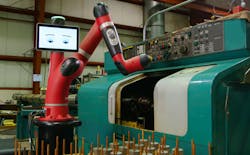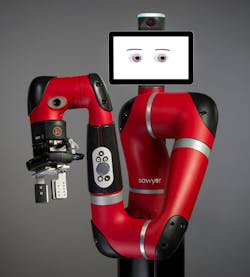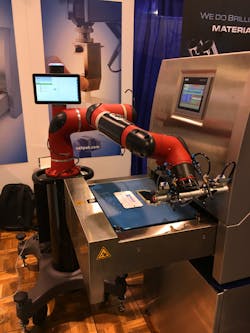How Collaborative Robots are Changing Medical Device Packaging
New and more stringent rules and quality regulations are emerging that are reshaping the future of many industries. However, one industry where this will have a substantial impact in the coming years is medical devices. Human error is no longer accepted as a “root cause,” leading to increasing demand to automate certain repeatable tasks in order to maximize productivity and effectively remove human error from the equation.
While the incorporation of robots provides a way to add automation to the medical device manufacturing process, traditional industrial robots can be costly and logistically prohibitive. These robots are generally limited to a single function, need to be programmed by highly paid and skilled specialists, and must be kept in cages or behind fences to prevent injury to human workers. These safety measures oftentimes require an overhaul of the manufacturing floor to accommodate the extensive space they require.
However, a new generation of collaborative robots (or “cobots”) is emerging as a viable alternative that allows humans and robots to work side-by-side in a more flexible, agile, and meaningful way. Cobots are safer to be around, require a much smaller footprint, and are affordable enough to provide a rapid return on investment.
Cobots in Action
Cobots are designed to work within the manufacturer’s existing infrastructure, without the need for safety caging – allowing them to interact with human line workers. Cobots are ideal for many tasks typically completed by humans, including packaging, and can often be inserted into the line seamlessly.
Incorporating cobots in the manufacturing process for extremely precise and quality-driven aspects of the medical device industry can help reduce human error and improve quality, ultimately resulting in an increased patient safety. An example of this type of application that stands to benefit significantly from cobots is medical device packaging. Ineffective packaging can have a negative impact on the efficacy of a medical device in the field or can even result in the entire device failing to get to market.
Collaborative robots are now being explored to automate certain steps in the heat sealing process for medical packaging. These robots can load trays and lids from the table top heat sealing machines, initiate the sealing cycle, and remove the sealed, sterilized package from the machine once complete. In other scenarios, they may be used to load and unload trays from a rotary heat sealing machine or pick up trays and present them to printing stations or package testing units.
The cobots can be closely situated alongside sealers and are able to navigate around the side of the sealing unit without touching it unintentionally. Immediately after the sealing process, the seal is still warm and has not reached its maximum strength. Touching the sealed area and possibly applying mechanical strain to it may compromise the quality of the seal and could impact the sterility of the medical device.
The unique type of adaptable automation enabled by the integration of cobots allows medical device packaging manufacturers to adjust to constant change, including short production runs, quick changes and modifications, seasonality, and ebbs and flows in demand.
Additionally, to accommodate the quality demands of the medical device market, cobots are certified to meet strict ISO requirements. The software platform can provide key performance indicators (KPIs) such as part counts, cycle times, speed, and signals in real time for accurate and efficient performance monitoring.
What’s Ahead for Cobots?
Cobots are poised to become part of a blended workforce where humans and robots work side by side. While cobots can help address labor shortages in both skilled and unskilled positions, the objective is not to replace human workers but to free them up to do what they’re best at – more complex, hard-to-automate tasks. Cobots can also help make the workplace safer for their human counterparts by taking on more dangerous tasks like reaching into machines.
Unlike industrial robots, software-driven cobots such as Sawyer are designed to be operated with minimal training and do not require any formal programming knowledge or a roboticist to deploy. This allows manufacturers to expedite successful deployments – from uncrating to starting a task in a matter of hours. Operators can adjust behaviors simply by demonstrating the physical motions required to complete a task.
The software can be updated on already-deployed cobots quickly, increasing functionality and enhancing the value of the hardware with a customizable display of data, graphs, and KPI. This allows operators and production managers to view valuable production metrics right on the factory floor.
The use of cobots will continue to grow within medical device OEMs. The blended workforce model is well-suited for packaging cell operations where operators and cobots work in close proximity, and for operations that demand agile and flexible manufacturing of typically short-run production lots that do not lend themselves to high-end automation.
Future Implementation
Companies in various sectors that have implemented cobots have reported successes in terms of increased overall production output, improved task accuracy, part quality, and a shift of human workers to more value-driven tasks and positions. The cobots provide added dexterity, ensuring each task is completed with precision and consistency in situations where the work is tedious and repetitive.
Cobots allow manufacturers from a variety of industries to automate more, while increasing productivity, improving quality and lowering cost. As the workforce ages, manufacturers need reliable, efficient workers and cobots provide a safe and dependable solution.
About the Author
Bert Verheugen
Vice President of Technical Support,
Bert Verheugen is the Vice President of Technical Support at Nelipak Healthcare Packaging.
Seán Egan
Director of Global Marketing
Seán Egan is the Director of Global Marketing at Nelipak Healthcare Packaging.



